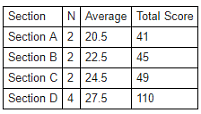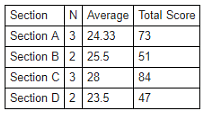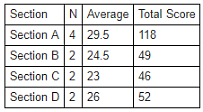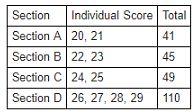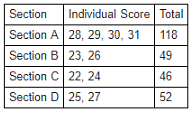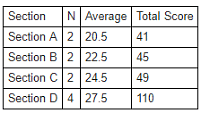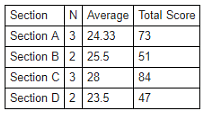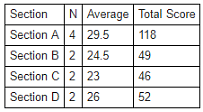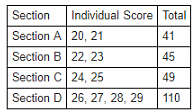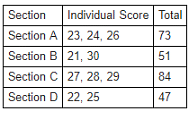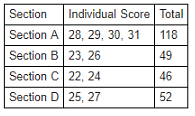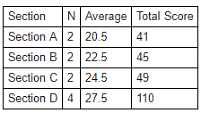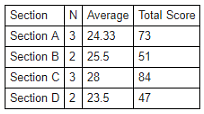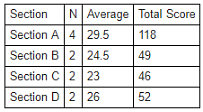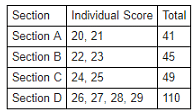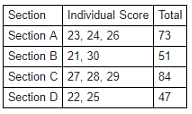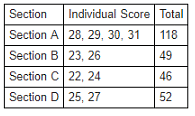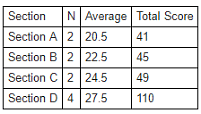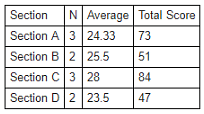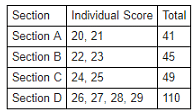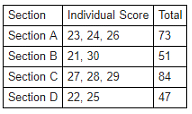CAT Mock Test - 19 - CAT MCQ
30 Questions MCQ Test CAT Mock Test Series 2024 - CAT Mock Test - 19
Direction: Read the passage carefully and answer the questions.
The recurring theme of equality in the United States has flared into a fervent moral issue at crucial stages: the Revolutionary and Jacksonian periods, the Civil War, the populist and progressive eras, the New Deal, and the 1960s and 1980s. The legitimacy of American society is challenged by some set of people unhappy with the degree of equality. New claims are laid, new understandings are reached, and new policies for political or economic equality are instituted. Yet the equality issue endures outside these moments of fervor. Ideologies in favor of extending equality are arrayed against others that would limit its scope; advocates of social justice confront defenders of liberty.
In the moments of egalitarian ascendancy, libertarians are on the defensive. In the moments of retrenchment, egalitarians cling to previous gains. And in either period the enemy is likely to be the "special interests " that have too much power. In egalitarian times, these are the moneyed interests. In times of retrenchment, these are labor or big government and its beneficiaries.
The moments of creedal passion, in Samuel Huntington's words, have usually been outbursts of egalitarianism. In part, the passion springs from the self—interest of those who would benefit from a more equal distribution of goods or political influence. But the passion also springs from ideology and values, including deep religious justifications for equality.
The passion accompanying the discovery or rediscovery that ideals do not match reality is particularly intense when the ideal is as deeply felt as is equality. Yet there can be passion on the nonegalitarian side as well. The self—interested passion to protect an established position may be even more powerful than the passion to redress inequality, though its expression may be more muted.
Devotion to inequality may also be based on ideals, such as liberty, individualism, and the free market, which are no less ancient and venerable. Like the ideals of equality, these alternative ideals serve as yardsticks for measuring whether society has moved away from its true principles.
Yet the spirit of reform during Reconstruction dissipated in the face of spent political struggles, sluggish social institutions, and outright mendacity. Society's entrepreneurial energy was channeled into economic activity, and the courts failed to endorse many of the reformers' grandest visions. The egalitarian thrust of the Populists around the turn of the century inspired an anti—egalitarian counterthrust over the next two decades.
Americans do not have an ideology that assigns clear priority to one value over any other. At every historical juncture where equality was an issue, its proponents failed to do all that they had set out to do. Swings in the equality of social conditions are restrained not just by institutional obstacles but by fundamental conflicts of values that are a traditional element of American politics. Faith in the individualistic work ethic and belief in the legitimacy of unequal wealth retard progression to the egalitarian left. As for conservatism, the indelible tenet of political equality firmly restrains the right and confirms a commitment to the disadvantaged. In seeking equal opportunity over equal result, Americans forego a ceiling, not a floor.
Q. A history professor contends that American egalitarian movements have been motivated entirely by selfish concerns. Which of the following best characterizes the relevance of this information to the passage?
Direction: Read the passage carefully and answer the questions.
The recurring theme of equality in the United States has flared into a fervent moral issue at crucial stages: the Revolutionary and Jacksonian periods, the Civil War, the populist and progressive eras, the New Deal, and the 1960s and 1980s. The legitimacy of American society is challenged by some set of people unhappy with the degree of equality. New claims are laid, new understandings are reached, and new policies for political or economic equality are instituted. Yet the equality issue endures outside these moments of fervor. Ideologies in favor of extending equality are arrayed against others that would limit its scope; advocates of social justice confront defenders of liberty.
In the moments of egalitarian ascendancy, libertarians are on the defensive. In the moments of retrenchment, egalitarians cling to previous gains. And in either period the enemy is likely to be the "special interests " that have too much power. In egalitarian times, these are the moneyed interests. In times of retrenchment, these are labor or big government and its beneficiaries.
The moments of creedal passion, in Samuel Huntington's words, have usually been outbursts of egalitarianism. In part, the passion springs from the self—interest of those who would benefit from a more equal distribution of goods or political influence. But the passion also springs from ideology and values, including deep religious justifications for equality.
The passion accompanying the discovery or rediscovery that ideals do not match reality is particularly intense when the ideal is as deeply felt as is equality. Yet there can be passion on the nonegalitarian side as well. The self—interested passion to protect an established position may be even more powerful than the passion to redress inequality, though its expression may be more muted.
Devotion to inequality may also be based on ideals, such as liberty, individualism, and the free market, which are no less ancient and venerable. Like the ideals of equality, these alternative ideals serve as yardsticks for measuring whether society has moved away from its true principles.
Yet the spirit of reform during Reconstruction dissipated in the face of spent political struggles, sluggish social institutions, and outright mendacity. Society's entrepreneurial energy was channeled into economic activity, and the courts failed to endorse many of the reformers' grandest visions. The egalitarian thrust of the Populists around the turn of the century inspired an anti—egalitarian counterthrust over the next two decades.
Americans do not have an ideology that assigns clear priority to one value over any other. At every historical juncture where equality was an issue, its proponents failed to do all that they had set out to do. Swings in the equality of social conditions are restrained not just by institutional obstacles but by fundamental conflicts of values that are a traditional element of American politics. Faith in the individualistic work ethic and belief in the legitimacy of unequal wealth retard progression to the egalitarian left. As for conservatism, the indelible tenet of political equality firmly restrains the right and confirms a commitment to the disadvantaged. In seeking equal opportunity over equal result, Americans forego a ceiling, not a floor.
Q. According to the passage, none of the following statements are true EXCEPT:
| 1 Crore+ students have signed up on EduRev. Have you? Download the App |
Direction: Read the passage carefully and answer the questions.
The recurring theme of equality in the United States has flared into a fervent moral issue at crucial stages: the Revolutionary and Jacksonian periods, the Civil War, the populist and progressive eras, the New Deal, and the 1960s and 1980s. The legitimacy of American society is challenged by some set of people unhappy with the degree of equality. New claims are laid, new understandings are reached, and new policies for political or economic equality are instituted. Yet the equality issue endures outside these moments of fervor. Ideologies in favor of extending equality are arrayed against others that would limit its scope; advocates of social justice confront defenders of liberty.
In the moments of egalitarian ascendancy, libertarians are on the defensive. In the moments of retrenchment, egalitarians cling to previous gains. And in either period the enemy is likely to be the "special interests " that have too much power. In egalitarian times, these are the moneyed interests. In times of retrenchment, these are labor or big government and its beneficiaries.
The moments of creedal passion, in Samuel Huntington's words, have usually been outbursts of egalitarianism. In part, the passion springs from the self—interest of those who would benefit from a more equal distribution of goods or political influence. But the passion also springs from ideology and values, including deep religious justifications for equality.
The passion accompanying the discovery or rediscovery that ideals do not match reality is particularly intense when the ideal is as deeply felt as is equality. Yet there can be passion on the nonegalitarian side as well. The self—interested passion to protect an established position may be even more powerful than the passion to redress inequality, though its expression may be more muted.
Devotion to inequality may also be based on ideals, such as liberty, individualism, and the free market, which are no less ancient and venerable. Like the ideals of equality, these alternative ideals serve as yardsticks for measuring whether society has moved away from its true principles.
Yet the spirit of reform during Reconstruction dissipated in the face of spent political struggles, sluggish social institutions, and outright mendacity. Society's entrepreneurial energy was channeled into economic activity, and the courts failed to endorse many of the reformers' grandest visions. The egalitarian thrust of the Populists around the turn of the century inspired an anti—egalitarian counterthrust over the next two decades.
Americans do not have an ideology that assigns clear priority to one value over any other. At every historical juncture where equality was an issue, its proponents failed to do all that they had set out to do. Swings in the equality of social conditions are restrained not just by institutional obstacles but by fundamental conflicts of values that are a traditional element of American politics. Faith in the individualistic work ethic and belief in the legitimacy of unequal wealth retard progression to the egalitarian left. As for conservatism, the indelible tenet of political equality firmly restrains the right and confirms a commitment to the disadvantaged. In seeking equal opportunity over equal result, Americans forego a ceiling, not a floor.
Q. In political discussions, the word enemy is bandied about with little regard for its precise meaning. In the context of the passage, the word, as used in the second passage, refers to:
Direction: Read the passage carefully and answer the questions.
The recurring theme of equality in the United States has flared into a fervent moral issue at crucial stages: the Revolutionary and Jacksonian periods, the Civil War, the populist and progressive eras, the New Deal, and the 1960s and 1980s. The legitimacy of American society is challenged by some set of people unhappy with the degree of equality. New claims are laid, new understandings are reached, and new policies for political or economic equality are instituted. Yet the equality issue endures outside these moments of fervor. Ideologies in favor of extending equality are arrayed against others that would limit its scope; advocates of social justice confront defenders of liberty.
In the moments of egalitarian ascendancy, libertarians are on the defensive. In the moments of retrenchment, egalitarians cling to previous gains. And in either period the enemy is likely to be the "special interests " that have too much power. In egalitarian times, these are the moneyed interests. In times of retrenchment, these are labor or big government and its beneficiaries.
The moments of creedal passion, in Samuel Huntington's words, have usually been outbursts of egalitarianism. In part, the passion springs from the self—interest of those who would benefit from a more equal distribution of goods or political influence. But the passion also springs from ideology and values, including deep religious justifications for equality.
The passion accompanying the discovery or rediscovery that ideals do not match reality is particularly intense when the ideal is as deeply felt as is equality. Yet there can be passion on the nonegalitarian side as well. The self—interested passion to protect an established position may be even more powerful than the passion to redress inequality, though its expression may be more muted.
Devotion to inequality may also be based on ideals, such as liberty, individualism, and the free market, which are no less ancient and venerable. Like the ideals of equality, these alternative ideals serve as yardsticks for measuring whether society has moved away from its true principles.
Yet the spirit of reform during Reconstruction dissipated in the face of spent political struggles, sluggish social institutions, and outright mendacity. Society's entrepreneurial energy was channeled into economic activity, and the courts failed to endorse many of the reformers' grandest visions. The egalitarian thrust of the Populists around the turn of the century inspired an anti—egalitarian counterthrust over the next two decades.
Americans do not have an ideology that assigns clear priority to one value over any other. At every historical juncture where equality was an issue, its proponents failed to do all that they had set out to do. Swings in the equality of social conditions are restrained not just by institutional obstacles but by fundamental conflicts of values that are a traditional element of American politics. Faith in the individualistic work ethic and belief in the legitimacy of unequal wealth retard progression to the egalitarian left. As for conservatism, the indelible tenet of political equality firmly restrains the right and confirms a commitment to the disadvantaged. In seeking equal opportunity over equal result, Americans forego a ceiling, not a floor.
Q. The existence of which of the following would most strongly challenge the author's view about the American public's ideology?
Direction: Read the passage carefully and answer the questions
The last ice age has left its telltales written quite clearly across the landscape. When Louis Agassiz first promulgated his theory that ice had once covered the Swiss countryside, he looked to the valleys there that retain glaciers to this day. Like other observers, he noted the presence of strange boulders, called "erratics, " tossed down in valleys like flotsam after a flood had drained away. He saw the strange polish along the bedrock—a sheen imparted as if by some massive swipe of sandpaper; he saw the debris of rocks and boulders fringing the margin of existing glaciers. He saw what can be seen still, markings in stone that indicated that ice once flowed over vast stretches of land now clear and verdant.
The first great glaciations must have scored the earth as deeply in their turn, and, in principle, we ought to be able to track the history of the early ice ages by following the same reasoning Agassiz used to persuade himself and his contemporaries that ice once covered the earth. But the marks left by these earlier glaciations are quite subtle, tracks turned ghostly with great age. There are, however, telltale deposits of ancient rocks that strongly suggest that they had been ground together and laid down by the spread of ice.
The Australian climate historian L.A. Frakes has prospected through various theories proposed to account for those early ice ages. He isn't terribly enthusiastic about any of the possible culprits, but his choice for the least unlikely of them all emerges out of the recent revival of what was once a radically unorthodox idea: that continents drift over the face of the planet. Frakes argues that the glaciers originated at sites near the poles and that the ice ages began because the continents of the early earth had drifted to positions that took more and more of their land nearer to the polar regions.
More land near the poles meant that more precipitation fell as snow and could be compacted on land to form glaciers. With enough glaciers, the increase in the amount of sunlight reflected back into space off the glistening white sheen of the ice effectively reduced the amount by which the sun warmed the earth, creating the feedback loop by which the growth of glaciers encouraged the growth of more glaciers. Rocks have been found in North America, Africa and Australia whose ages appear to hover around the 2.3 billion—year—old mark. That date and their spread are vague enough, however, to make it almost impossible to determine just how much of the earth was icebound during the possible range of time in which each of the glacial deposits was formed.
Uncertainties about both the timing and the extent of these glaciers also muddy the search for the cause of the ancient ice ages. The record is so spotty that geologists are not sure whether areas near the equator or nearer the poles were the coolest places on earth. It's also possible that volcanic eruptions had tossed enough dust into the atmosphere to screen out sunlight and cool the earth. While some of the glacial records in the rocks do indeed contain evidence of volcanic activity prior to the buildup of glacial debris, others do not.
Such traces are the currency of science—data—and like money, a richness of data both buys you some credibility and ties you down, eliminating at least some theoretically plausible explanations. For this early period, theorists have come up with a variety of ideas to explain the ancient ice ages, all elegant and mostly immune to both proof and criticism. For example, a change in the earth's orbit could have reduced the amount of sunlight reaching the planet. However, the only physical signature of such an event that would show in the rocks would be the marks of the glaciers themselves.
Q. Suppose that an advocate of the "change in orbit " theory of the ancient ice ages criticizes a defender of the "volcanic eruption " theory on the grounds that only some of the glacial records contain evidence of prior volcanic activity. The defender might justifiably counter this attack by pointing out that:
Direction: Read the passage carefully and answer the questions
The last ice age has left its telltales written quite clearly across the landscape. When Louis Agassiz first promulgated his theory that ice had once covered the Swiss countryside, he looked to the valleys there that retain glaciers to this day. Like other observers, he noted the presence of strange boulders, called "erratics, " tossed down in valleys like flotsam after a flood had drained away. He saw the strange polish along the bedrock—a sheen imparted as if by some massive swipe of sandpaper; he saw the debris of rocks and boulders fringing the margin of existing glaciers. He saw what can be seen still, markings in stone that indicated that ice once flowed over vast stretches of land now clear and verdant.
The first great glaciations must have scored the earth as deeply in their turn, and, in principle, we ought to be able to track the history of the early ice ages by following the same reasoning Agassiz used to persuade himself and his contemporaries that ice once covered the earth. But the marks left by these earlier glaciations are quite subtle, tracks turned ghostly with great age. There are, however, telltale deposits of ancient rocks that strongly suggest that they had been ground together and laid down by the spread of ice.
The Australian climate historian L.A. Frakes has prospected through various theories proposed to account for those early ice ages. He isn't terribly enthusiastic about any of the possible culprits, but his choice for the least unlikely of them all emerges out of the recent revival of what was once a radically unorthodox idea: that continents drift over the face of the planet. Frakes argues that the glaciers originated at sites near the poles and that the ice ages began because the continents of the early earth had drifted to positions that took more and more of their land nearer to the polar regions.
More land near the poles meant that more precipitation fell as snow and could be compacted on land to form glaciers. With enough glaciers, the increase in the amount of sunlight reflected back into space off the glistening white sheen of the ice effectively reduced the amount by which the sun warmed the earth, creating the feedback loop by which the growth of glaciers encouraged the growth of more glaciers. Rocks have been found in North America, Africa and Australia whose ages appear to hover around the 2.3 billion—year—old mark. That date and their spread are vague enough, however, to make it almost impossible to determine just how much of the earth was icebound during the possible range of time in which each of the glacial deposits was formed.
Uncertainties about both the timing and the extent of these glaciers also muddy the search for the cause of the ancient ice ages. The record is so spotty that geologists are not sure whether areas near the equator or nearer the poles were the coolest places on earth. It's also possible that volcanic eruptions had tossed enough dust into the atmosphere to screen out sunlight and cool the earth. While some of the glacial records in the rocks do indeed contain evidence of volcanic activity prior to the buildup of glacial debris, others do not.
Such traces are the currency of science—data—and like money, a richness of data both buys you some credibility and ties you down, eliminating at least some theoretically plausible explanations. For this early period, theorists have come up with a variety of ideas to explain the ancient ice ages, all elegant and mostly immune to both proof and criticism. For example, a change in the earth's orbit could have reduced the amount of sunlight reaching the planet. However, the only physical signature of such an event that would show in the rocks would be the marks of the glaciers themselves.
Q. According to the passage, which of the following is most likely to be true about the relationship between the amount of data one has about a phenomenon and the number of theoretically plausible explanations?
Direction: Read the passage carefully and answer the questions
The last ice age has left its telltales written quite clearly across the landscape. When Louis Agassiz first promulgated his theory that ice had once covered the Swiss countryside, he looked to the valleys there that retain glaciers to this day. Like other observers, he noted the presence of strange boulders, called "erratics, " tossed down in valleys like flotsam after a flood had drained away. He saw the strange polish along the bedrock—a sheen imparted as if by some massive swipe of sandpaper; he saw the debris of rocks and boulders fringing the margin of existing glaciers. He saw what can be seen still, markings in stone that indicated that ice once flowed over vast stretches of land now clear and verdant.
The first great glaciations must have scored the earth as deeply in their turn, and, in principle, we ought to be able to track the history of the early ice ages by following the same reasoning Agassiz used to persuade himself and his contemporaries that ice once covered the earth. But the marks left by these earlier glaciations are quite subtle, tracks turned ghostly with great age. There are, however, telltale deposits of ancient rocks that strongly suggest that they had been ground together and laid down by the spread of ice.
The Australian climate historian L.A. Frakes has prospected through various theories proposed to account for those early ice ages. He isn't terribly enthusiastic about any of the possible culprits, but his choice for the least unlikely of them all emerges out of the recent revival of what was once a radically unorthodox idea: that continents drift over the face of the planet. Frakes argues that the glaciers originated at sites near the poles and that the ice ages began because the continents of the early earth had drifted to positions that took more and more of their land nearer to the polar regions.
More land near the poles meant that more precipitation fell as snow and could be compacted on land to form glaciers. With enough glaciers, the increase in the amount of sunlight reflected back into space off the glistening white sheen of the ice effectively reduced the amount by which the sun warmed the earth, creating the feedback loop by which the growth of glaciers encouraged the growth of more glaciers. Rocks have been found in North America, Africa and Australia whose ages appear to hover around the 2.3 billion—year—old mark. That date and their spread are vague enough, however, to make it almost impossible to determine just how much of the earth was icebound during the possible range of time in which each of the glacial deposits was formed.
Uncertainties about both the timing and the extent of these glaciers also muddy the search for the cause of the ancient ice ages. The record is so spotty that geologists are not sure whether areas near the equator or nearer the poles were the coolest places on earth. It's also possible that volcanic eruptions had tossed enough dust into the atmosphere to screen out sunlight and cool the earth. While some of the glacial records in the rocks do indeed contain evidence of volcanic activity prior to the buildup of glacial debris, others do not.
Such traces are the currency of science—data—and like money, a richness of data both buys you some credibility and ties you down, eliminating at least some theoretically plausible explanations. For this early period, theorists have come up with a variety of ideas to explain the ancient ice ages, all elegant and mostly immune to both proof and criticism. For example, a change in the earth's orbit could have reduced the amount of sunlight reaching the planet. However, the only physical signature of such an event that would show in the rocks would be the marks of the glaciers themselves.
Q. There is an implicit assumption in the statement that geologists don't know whether the coolest places on earth were near the poles or near the equator. The assumption is that:
Direction: Read the passage carefully and answer the questions
The last ice age has left its telltales written quite clearly across the landscape. When Louis Agassiz first promulgated his theory that ice had once covered the Swiss countryside, he looked to the valleys there that retain glaciers to this day. Like other observers, he noted the presence of strange boulders, called "erratics, " tossed down in valleys like flotsam after a flood had drained away. He saw the strange polish along the bedrock—a sheen imparted as if by some massive swipe of sandpaper; he saw the debris of rocks and boulders fringing the margin of existing glaciers. He saw what can be seen still, markings in stone that indicated that ice once flowed over vast stretches of land now clear and verdant.
The first great glaciations must have scored the earth as deeply in their turn, and, in principle, we ought to be able to track the history of the early ice ages by following the same reasoning Agassiz used to persuade himself and his contemporaries that ice once covered the earth. But the marks left by these earlier glaciations are quite subtle, tracks turned ghostly with great age. There are, however, telltale deposits of ancient rocks that strongly suggest that they had been ground together and laid down by the spread of ice.
The Australian climate historian L.A. Frakes has prospected through various theories proposed to account for those early ice ages. He isn't terribly enthusiastic about any of the possible culprits, but his choice for the least unlikely of them all emerges out of the recent revival of what was once a radically unorthodox idea: that continents drift over the face of the planet. Frakes argues that the glaciers originated at sites near the poles and that the ice ages began because the continents of the early earth had drifted to positions that took more and more of their land nearer to the polar regions.
More land near the poles meant that more precipitation fell as snow and could be compacted on land to form glaciers. With enough glaciers, the increase in the amount of sunlight reflected back into space off the glistening white sheen of the ice effectively reduced the amount by which the sun warmed the earth, creating the feedback loop by which the growth of glaciers encouraged the growth of more glaciers. Rocks have been found in North America, Africa and Australia whose ages appear to hover around the 2.3 billion—year—old mark. That date and their spread are vague enough, however, to make it almost impossible to determine just how much of the earth was icebound during the possible range of time in which each of the glacial deposits was formed.
Uncertainties about both the timing and the extent of these glaciers also muddy the search for the cause of the ancient ice ages. The record is so spotty that geologists are not sure whether areas near the equator or nearer the poles were the coolest places on earth. It's also possible that volcanic eruptions had tossed enough dust into the atmosphere to screen out sunlight and cool the earth. While some of the glacial records in the rocks do indeed contain evidence of volcanic activity prior to the buildup of glacial debris, others do not.
Such traces are the currency of science—data—and like money, a richness of data both buys you some credibility and ties you down, eliminating at least some theoretically plausible explanations. For this early period, theorists have come up with a variety of ideas to explain the ancient ice ages, all elegant and mostly immune to both proof and criticism. For example, a change in the earth's orbit could have reduced the amount of sunlight reaching the planet. However, the only physical signature of such an event that would show in the rocks would be the marks of the glaciers themselves.
Q. Based on the passage, with which of the following statements would the author most likely NOT disagree?
Direction: Read the passage carefully and answer the questions
As opera becomes more popular in America the scarcity of theaters and the unconscionably costly logistics of the lyric stage make it difficult to meet the demand. Many a good—sized and well—to—do community would be able to operate and maintain a modest but live opera theater, but are unwilling to do so because it would unfavorably compare with the splendors of New York's Metropolitan Opera.
It is not realized that the rich operatic culture of Italy and Germany is mainly due to their many small municipal theaters which alternate repertory theater with opera. These circumstances have led to concert or "semi—staged " performances which, formerly an exception, now occupy entire companies expressly formed for this purpose. However, stage music, real operatic music, often fails to exert its full power in the frozen formality of the concert platform. In a true opera the particular charm and power of the music does not come through without staging and acting, for gesture is an expression of feeling, and the decor and costumes summarize the external aspects, providing a vision of the whole action. Both are to a considerable degree determined by the music, but they also complement it.
An opera is a play in music. If it is presented in concert version, then it should not offer a half—hearted gesture towards the theater. Indeed, the "partly staged " performances are even more unsatisfactory than the concert variety. The tenor is all excited, but you do not know why; the soprano is obviously dying, but she remains on her feet. Nor does the stationary chorus, its members turning the pages of their scores without looking at the person they sing about, contribute to the illusion.
Different aesthetic laws of governance apply to concert music and theatrical music, for they are incongruous worlds calling for an entirely different sort of imagination from both performers and audience. Opera is theater, the most involved, elaborate, and exciting form of theater. The Italian term "opera " is far more inclusive than its English interpretation, for it embraces not only the musical score but the whole theater, "the work. "
Without the stage, paucity of musical ideas immediately becomes evident, often painfully so. Take for instance Richard Strauss, some of whose late operas are being performed in concerts. Strauss was a composer who knew every facet of the lyric stage as few have known it, yet what can be quite pleasant on the stage, even if it is not particularly inventive, appears bare and contrived when removed from its natural habitat.
Some may say that the end justifies the means. I can see merit in the concert performance of an opera which otherwise could not hope to be heard, or of one deficient in true theatrical qualities yet of genuine musical value. But neither Strauss, nor Bellini, nor Donizetti qualifies for such a role. Even if we forget the vital function of staging, it is practically impossible, for purely musical reasons, to present such a work on the concert platform. The large orchestra belongs in the pit; when placed on the stage, together with the singers, it makes their position almost untenable, even when led by an experienced opera conductor.
Q. The author discusses "opera " in a very particular way in the fourth paragraph of the passage. Implicit in the author's discussion of the term is the idea that:
Direction: Read the passage carefully and answer the questions
As opera becomes more popular in America the scarcity of theaters and the unconscionably costly logistics of the lyric stage make it difficult to meet the demand. Many a good—sized and well—to—do community would be able to operate and maintain a modest but live opera theater, but are unwilling to do so because it would unfavorably compare with the splendors of New York's Metropolitan Opera.
It is not realized that the rich operatic culture of Italy and Germany is mainly due to their many small municipal theaters which alternate repertory theater with opera. These circumstances have led to concert or "semi—staged " performances which, formerly an exception, now occupy entire companies expressly formed for this purpose. However, stage music, real operatic music, often fails to exert its full power in the frozen formality of the concert platform. In a true opera the particular charm and power of the music does not come through without staging and acting, for gesture is an expression of feeling, and the decor and costumes summarize the external aspects, providing a vision of the whole action. Both are to a considerable degree determined by the music, but they also complement it.
An opera is a play in music. If it is presented in concert version, then it should not offer a half—hearted gesture towards the theater. Indeed, the "partly staged " performances are even more unsatisfactory than the concert variety. The tenor is all excited, but you do not know why; the soprano is obviously dying, but she remains on her feet. Nor does the stationary chorus, its members turning the pages of their scores without looking at the person they sing about, contribute to the illusion.
Different aesthetic laws of governance apply to concert music and theatrical music, for they are incongruous worlds calling for an entirely different sort of imagination from both performers and audience. Opera is theater, the most involved, elaborate, and exciting form of theater. The Italian term "opera " is far more inclusive than its English interpretation, for it embraces not only the musical score but the whole theater, "the work. "
Without the stage, paucity of musical ideas immediately becomes evident, often painfully so. Take for instance Richard Strauss, some of whose late operas are being performed in concerts. Strauss was a composer who knew every facet of the lyric stage as few have known it, yet what can be quite pleasant on the stage, even if it is not particularly inventive, appears bare and contrived when removed from its natural habitat.
Some may say that the end justifies the means. I can see merit in the concert performance of an opera which otherwise could not hope to be heard, or of one deficient in true theatrical qualities yet of genuine musical value. But neither Strauss, nor Bellini, nor Donizetti qualifies for such a role. Even if we forget the vital function of staging, it is practically impossible, for purely musical reasons, to present such a work on the concert platform. The large orchestra belongs in the pit; when placed on the stage, together with the singers, it makes their position almost untenable, even when led by an experienced opera conductor.
Q. Bellini's works have historically been considered to possess both true theatrical quality and genuine musical value. What is the relevance of this information to the passage?
Direction: Read the passage carefully and answer the questions
As opera becomes more popular in America the scarcity of theaters and the unconscionably costly logistics of the lyric stage make it difficult to meet the demand. Many a good—sized and well—to—do community would be able to operate and maintain a modest but live opera theater, but are unwilling to do so because it would unfavorably compare with the splendors of New York's Metropolitan Opera.
It is not realized that the rich operatic culture of Italy and Germany is mainly due to their many small municipal theaters which alternate repertory theater with opera. These circumstances have led to concert or "semi—staged " performances which, formerly an exception, now occupy entire companies expressly formed for this purpose. However, stage music, real operatic music, often fails to exert its full power in the frozen formality of the concert platform. In a true opera the particular charm and power of the music does not come through without staging and acting, for gesture is an expression of feeling, and the decor and costumes summarize the external aspects, providing a vision of the whole action. Both are to a considerable degree determined by the music, but they also complement it.
An opera is a play in music. If it is presented in concert version, then it should not offer a half—hearted gesture towards the theater. Indeed, the "partly staged " performances are even more unsatisfactory than the concert variety. The tenor is all excited, but you do not know why; the soprano is obviously dying, but she remains on her feet. Nor does the stationary chorus, its members turning the pages of their scores without looking at the person they sing about, contribute to the illusion.
Different aesthetic laws of governance apply to concert music and theatrical music, for they are incongruous worlds calling for an entirely different sort of imagination from both performers and audience. Opera is theater, the most involved, elaborate, and exciting form of theater. The Italian term "opera " is far more inclusive than its English interpretation, for it embraces not only the musical score but the whole theater, "the work. "
Without the stage, paucity of musical ideas immediately becomes evident, often painfully so. Take for instance Richard Strauss, some of whose late operas are being performed in concerts. Strauss was a composer who knew every facet of the lyric stage as few have known it, yet what can be quite pleasant on the stage, even if it is not particularly inventive, appears bare and contrived when removed from its natural habitat.
Some may say that the end justifies the means. I can see merit in the concert performance of an opera which otherwise could not hope to be heard, or of one deficient in true theatrical qualities yet of genuine musical value. But neither Strauss, nor Bellini, nor Donizetti qualifies for such a role. Even if we forget the vital function of staging, it is practically impossible, for purely musical reasons, to present such a work on the concert platform. The large orchestra belongs in the pit; when placed on the stage, together with the singers, it makes their position almost untenable, even when led by an experienced opera conductor.
Q. Take, as an example, an opera that contains strong musical ideas throughout its score and suppose that it will be performed in concert. According to the passage, the presentation will:
Direction: Read the passage carefully and answer the questions
As opera becomes more popular in America the scarcity of theaters and the unconscionably costly logistics of the lyric stage make it difficult to meet the demand. Many a good—sized and well—to—do community would be able to operate and maintain a modest but live opera theater, but are unwilling to do so because it would unfavorably compare with the splendors of New York's Metropolitan Opera.
It is not realized that the rich operatic culture of Italy and Germany is mainly due to their many small municipal theaters which alternate repertory theater with opera. These circumstances have led to concert or "semi—staged " performances which, formerly an exception, now occupy entire companies expressly formed for this purpose. However, stage music, real operatic music, often fails to exert its full power in the frozen formality of the concert platform. In a true opera the particular charm and power of the music does not come through without staging and acting, for gesture is an expression of feeling, and the decor and costumes summarize the external aspects, providing a vision of the whole action. Both are to a considerable degree determined by the music, but they also complement it.
An opera is a play in music. If it is presented in concert version, then it should not offer a half—hearted gesture towards the theater. Indeed, the "partly staged " performances are even more unsatisfactory than the concert variety. The tenor is all excited, but you do not know why; the soprano is obviously dying, but she remains on her feet. Nor does the stationary chorus, its members turning the pages of their scores without looking at the person they sing about, contribute to the illusion.
Different aesthetic laws of governance apply to concert music and theatrical music, for they are incongruous worlds calling for an entirely different sort of imagination from both performers and audience. Opera is theater, the most involved, elaborate, and exciting form of theater. The Italian term "opera " is far more inclusive than its English interpretation, for it embraces not only the musical score but the whole theater, "the work. "
Without the stage, paucity of musical ideas immediately becomes evident, often painfully so. Take for instance Richard Strauss, some of whose late operas are being performed in concerts. Strauss was a composer who knew every facet of the lyric stage as few have known it, yet what can be quite pleasant on the stage, even if it is not particularly inventive, appears bare and contrived when removed from its natural habitat.
Some may say that the end justifies the means. I can see merit in the concert performance of an opera which otherwise could not hope to be heard, or of one deficient in true theatrical qualities yet of genuine musical value. But neither Strauss, nor Bellini, nor Donizetti qualifies for such a role. Even if we forget the vital function of staging, it is practically impossible, for purely musical reasons, to present such a work on the concert platform. The large orchestra belongs in the pit; when placed on the stage, together with the singers, it makes their position almost untenable, even when led by an experienced opera conductor.
Q. Which of the following statements seems most in agreement with the attitude of most "good—sized and well—to—do " communities regarding opera?
Directions: Read the following passage carefully and answer the given question.
The opposition between 'nature' and 'culture' is problematic for many reasons, but there's one that we rarely discuss. The 'nature vs culture' dualism leaves out an entire domain that properly belongs to neither: the world of waste. The mountains of waste that we produce every year or the new cosmos of micro-plastics expanding through our oceans – none of these have ever been entered into the ledger under 'culture'. Waste is precisely what dissolves the distinction between nature and culture. Nature and waste have fused at both planetary and microbiological scales. Similarly, waste is not merely a by-product of culture: it is culture. To focus our gaze on waste is not an act of morbid negativity; it is an act of cultural realism. If we look at the material ages of human history, from the Stone Age and the Bronze Age through to the Steam Age and the Information Age, we get the illusory sense that hard things are dematerialising. In fact, the opposite is true. The Steam Age launched a great explosion of material goods that has mushroomed exponentially ever since, while statistics about our current rates of waste numb the mind.
To say that we live in a Waste Age is to acknowledge both its geological and economic dimensions. It is to acknowledge that growth is entirely dependent on the relentless and ruthlessly efficient generation of waste. Is this an ungenerous and pessimistic take on human activity in the 21st century? On the contrary. Invoking the Waste Age offers the opportunity for a radical shift in late-capitalist civilisation. By recognising the scale of the crisis can we reorient society and the economy towards less polluting modes of producing, consuming and living.
The problem is that waste has always been a marginal issue, both literally and figuratively. It has been dumped in and on the peripheries, consigned to that mythical place called 'away'. It has always been an 'externality', an unavoidable byproduct of necessary industrialisation. But it is now an internality – internal to every ecosystem and every digestive system from marine micro-organisms to humans. To invoke the Waste Age is to usher in the hope of a cleaner future.
Contrary to what we might assume, wastefulness is not a natural human instinct – we had to be taught how to do it. Consumers had to be persuaded that this magical new substance – plastic – was not too good to be thrown away. Some observers were quick to disapprove. Vance Packard's details at length the different forms of planned obsolescence, from products engineered to fail to those that are simply meant to be more desirable than last year's model. It is understood that such obsolescence is a necessary feature of a healthy economy – from politicians to cynical businessmen to consumers who think it is their patriotic duty to shop and support the economy. The very idea of the 'lifetime guarantee' conjured up the spectre of unemployment and shuttered factories. You might think that I'm suggesting that recycling is the answer to this crisis. Recycling rates are pathetically inadequate, and in many countries the system is essentially broken. The notion of recycling works to justify the production of more virgin plastics and other materials, as if it's alright because they will be recycled.
Q. The author of this passage is LEAST likely to agree with which of the following:
Directions: Read the following passage carefully and answer the given question.
The opposition between 'nature' and 'culture' is problematic for many reasons, but there's one that we rarely discuss. The 'nature vs culture' dualism leaves out an entire domain that properly belongs to neither: the world of waste. The mountains of waste that we produce every year or the new cosmos of micro-plastics expanding through our oceans – none of these have ever been entered into the ledger under 'culture'. Waste is precisely what dissolves the distinction between nature and culture. Nature and waste have fused at both planetary and microbiological scales. Similarly, waste is not merely a by-product of culture: it is culture. To focus our gaze on waste is not an act of morbid negativity; it is an act of cultural realism. If we look at the material ages of human history, from the Stone Age and the Bronze Age through to the Steam Age and the Information Age, we get the illusory sense that hard things are dematerialising. In fact, the opposite is true. The Steam Age launched a great explosion of material goods that has mushroomed exponentially ever since, while statistics about our current rates of waste numb the mind.
To say that we live in a Waste Age is to acknowledge both its geological and economic dimensions. It is to acknowledge that growth is entirely dependent on the relentless and ruthlessly efficient generation of waste. Is this an ungenerous and pessimistic take on human activity in the 21st century? On the contrary. Invoking the Waste Age offers the opportunity for a radical shift in late-capitalist civilisation. By recognising the scale of the crisis can we reorient society and the economy towards less polluting modes of producing, consuming and living.
The problem is that waste has always been a marginal issue, both literally and figuratively. It has been dumped in and on the peripheries, consigned to that mythical place called 'away'. It has always been an 'externality', an unavoidable byproduct of necessary industrialisation. But it is now an internality – internal to every ecosystem and every digestive system from marine micro-organisms to humans. To invoke the Waste Age is to usher in the hope of a cleaner future.
Contrary to what we might assume, wastefulness is not a natural human instinct – we had to be taught how to do it. Consumers had to be persuaded that this magical new substance – plastic – was not too good to be thrown away. Some observers were quick to disapprove. Vance Packard's details at length the different forms of planned obsolescence, from products engineered to fail to those that are simply meant to be more desirable than last year's model. It is understood that such obsolescence is a necessary feature of a healthy economy – from politicians to cynical businessmen to consumers who think it is their patriotic duty to shop and support the economy. The very idea of the 'lifetime guarantee' conjured up the spectre of unemployment and shuttered factories. You might think that I'm suggesting that recycling is the answer to this crisis. Recycling rates are pathetically inadequate, and in many countries the system is essentially broken. The notion of recycling works to justify the production of more virgin plastics and other materials, as if it's alright because they will be recycled.
Q. Which of the following can be best inferred about ''cultural realism'' as mentioned in the first paragraph of the passage?
Directions: Read the following passage carefully and answer the given question.
The opposition between 'nature' and 'culture' is problematic for many reasons, but there's one that we rarely discuss. The 'nature vs culture' dualism leaves out an entire domain that properly belongs to neither: the world of waste. The mountains of waste that we produce every year or the new cosmos of micro-plastics expanding through our oceans – none of these have ever been entered into the ledger under 'culture'. Waste is precisely what dissolves the distinction between nature and culture. Nature and waste have fused at both planetary and microbiological scales. Similarly, waste is not merely a by-product of culture: it is culture. To focus our gaze on waste is not an act of morbid negativity; it is an act of cultural realism. If we look at the material ages of human history, from the Stone Age and the Bronze Age through to the Steam Age and the Information Age, we get the illusory sense that hard things are dematerialising. In fact, the opposite is true. The Steam Age launched a great explosion of material goods that has mushroomed exponentially ever since, while statistics about our current rates of waste numb the mind.
To say that we live in a Waste Age is to acknowledge both its geological and economic dimensions. It is to acknowledge that growth is entirely dependent on the relentless and ruthlessly efficient generation of waste. Is this an ungenerous and pessimistic take on human activity in the 21st century? On the contrary. Invoking the Waste Age offers the opportunity for a radical shift in late-capitalist civilisation. By recognising the scale of the crisis can we reorient society and the economy towards less polluting modes of producing, consuming and living.
The problem is that waste has always been a marginal issue, both literally and figuratively. It has been dumped in and on the peripheries, consigned to that mythical place called 'away'. It has always been an 'externality', an unavoidable byproduct of necessary industrialisation. But it is now an internality – internal to every ecosystem and every digestive system from marine micro-organisms to humans. To invoke the Waste Age is to usher in the hope of a cleaner future.
Contrary to what we might assume, wastefulness is not a natural human instinct – we had to be taught how to do it. Consumers had to be persuaded that this magical new substance – plastic – was not too good to be thrown away. Some observers were quick to disapprove. Vance Packard's details at length the different forms of planned obsolescence, from products engineered to fail to those that are simply meant to be more desirable than last year's model. It is understood that such obsolescence is a necessary feature of a healthy economy – from politicians to cynical businessmen to consumers who think it is their patriotic duty to shop and support the economy. The very idea of the 'lifetime guarantee' conjured up the spectre of unemployment and shuttered factories. You might think that I'm suggesting that recycling is the answer to this crisis. Recycling rates are pathetically inadequate, and in many countries the system is essentially broken. The notion of recycling works to justify the production of more virgin plastics and other materials, as if it's alright because they will be recycled.
Q. ''It has been dumped in and on the peripheries, consigned to that mythical place called 'away'.'' Which of the following can be inferred when the author states this in the passage?
Directions: Read the following passage carefully and answer the given question.
The opposition between 'nature' and 'culture' is problematic for many reasons, but there's one that we rarely discuss. The 'nature vs culture' dualism leaves out an entire domain that properly belongs to neither: the world of waste. The mountains of waste that we produce every year or the new cosmos of micro-plastics expanding through our oceans – none of these have ever been entered into the ledger under 'culture'. Waste is precisely what dissolves the distinction between nature and culture. Nature and waste have fused at both planetary and microbiological scales. Similarly, waste is not merely a by-product of culture: it is culture. To focus our gaze on waste is not an act of morbid negativity; it is an act of cultural realism. If we look at the material ages of human history, from the Stone Age and the Bronze Age through to the Steam Age and the Information Age, we get the illusory sense that hard things are dematerialising. In fact, the opposite is true. The Steam Age launched a great explosion of material goods that has mushroomed exponentially ever since, while statistics about our current rates of waste numb the mind.
To say that we live in a Waste Age is to acknowledge both its geological and economic dimensions. It is to acknowledge that growth is entirely dependent on the relentless and ruthlessly efficient generation of waste. Is this an ungenerous and pessimistic take on human activity in the 21st century? On the contrary. Invoking the Waste Age offers the opportunity for a radical shift in late-capitalist civilisation. By recognising the scale of the crisis can we reorient society and the economy towards less polluting modes of producing, consuming and living.
The problem is that waste has always been a marginal issue, both literally and figuratively. It has been dumped in and on the peripheries, consigned to that mythical place called 'away'. It has always been an 'externality', an unavoidable byproduct of necessary industrialisation. But it is now an internality – internal to every ecosystem and every digestive system from marine micro-organisms to humans. To invoke the Waste Age is to usher in the hope of a cleaner future.
Contrary to what we might assume, wastefulness is not a natural human instinct – we had to be taught how to do it. Consumers had to be persuaded that this magical new substance – plastic – was not too good to be thrown away. Some observers were quick to disapprove. Vance Packard's details at length the different forms of planned obsolescence, from products engineered to fail to those that are simply meant to be more desirable than last year's model. It is understood that such obsolescence is a necessary feature of a healthy economy – from politicians to cynical businessmen to consumers who think it is their patriotic duty to shop and support the economy. The very idea of the 'lifetime guarantee' conjured up the spectre of unemployment and shuttered factories. You might think that I'm suggesting that recycling is the answer to this crisis. Recycling rates are pathetically inadequate, and in many countries the system is essentially broken. The notion of recycling works to justify the production of more virgin plastics and other materials, as if it's alright because they will be recycled.
Q. The author of the passage is LEAST likely to agree with which of the following statements?
Directions: The four sentences (labelled 1, 2, 3, and 4) below, when properly sequenced, would yield a coherent paragraph. Decide on the proper sequencing of the order of the sentences and key in the sequence of the four numbers as your answer.
1. Because our cognitive resources are limited, we can focus our attention on a single task only for a finite amount of time.
2. Various findings may seem to coalesce on the idea that multitasking is bad and should be avoided at all costs.
3. But actually I believe that people cannot avoid multitasking, nor should they necessarily try to.
4. Putting your phone in focus or airplane mode may seem like good advice, but often that simply isn't practical due to the need to be available to others.
Directions: The four sentences (labelled 1, 2, 3 and 4) given in this question, when properly sequenced, form a coherent paragraph. Decide on the proper order for the sentences and key in this sequence of four numbers as your answer.
1. Work stress poses risk to the physical health of the employee and consequently influences the health of the organisation.
2. No professional is untouched by stress, starting from a surgeon to an artist or a sales executive to a commercial pilot.
3. Job stress, in the early stages, can 'rev up' the body and improve performance in the workplace.
4. Although, the performance will eventually decline as the person's health will deteriorate.
Directions: The four sentences (labelled 1, 2, 3, and 4) below, when properly sequenced, would yield a coherent paragraph. Decide on the proper sequencing of the order of the sentences and key in the sequence of the four numbers as your answer.
1. Security threats, as well as social issues, have led states to cooperate with each other in regard to tightening up border controls, applying strict restrictions to visa applications and issuing severe fines and punishment for those contributing to the illicit transportation of migrants.
2. Failure to get this balance right jeopardises the safety of both the migrants and the state.
3. Various states, geographically unfortunately placed, receive inequitable amounts of irregular migrants, a large proportion of whom seek asylum.
4. The balance between a robust and acceptable migration policy against the states' internal security is a constant dilemma for governments.
Five jumbled-up sentences, related to a topic, are given below. Four of them can be put together to form a coherent paragraph. Identify the odd one out and key in the number of the sentence as your answer.
1. The Renaissance was an era of profound cultural rejuvenation rooted in classical antiquity.
2. It marked an age where scientific inquiry was championed alongside artistic creativity.
3. Great thinkers during the period were often persecuted, facing charges of heresy.
4. Notably, this period saw the genesis of masterpiece paintings that remain invaluable today.
5. Conversely, the Dark Ages were marked by widespread illiteracy and the stagnation of cultural progress.
Five jumbled-up sentences, related to a topic, are given below. Four of them can be put together to form a coherent paragraph. Identify the odd one out and key in the number of the sentence as your answer.
1. Deep-sea exploration has unveiled bizarre, alien-like creatures previously unknown to science.
2. These expeditions demand highly advanced technology to survive the ocean's crushing depths.
3. Discoveries made in these realms are often used in developing new materials and medical innovations.
4. The Mariana Trench, the deepest known point, extends nearly 11 kilometers down, farther than Mount Everest is tall.
5. Space travel requires complex calculations to overcome Earth's gravity.
Directions: The passage given below is followed by four alternative summaries. Choose the option that best captures the essence of the passage.
Sustaining a social movement is difficult, especially if its constituents come from socioeconomically disenfranchised backgrounds and are cynical about their chances of success. Attending marches and protests could be costly. The prospects of being imprisoned or persecuted are daunting. Against these obstacles, anger rallies people together - it transforms public, societal causes into intimate, personal reasons that you care about and are devoted to. By providing the individual with the instinctive justification to keep believing and carrying on, anger spurs and sustains action, even if the odds of succeeding are slim.
Directions: The passage given below is followed by four alternative summaries. Choose the option that best captures the essence of the passage.
Together with Martha Nussbaum, Sen formulated an alternative for understanding wellbeing: the capability approach, which stipulates that both personal characteristics and social circumstances affect what people can achieve with a given amount of resources. Giving books to a person who cannot read does not increase their wellbeing, just as providing them with a car does not increase mobility if there are no decent roads. According to Sen, what the person manages to do or to be - such as being well-nourished or being able to appear in public without shame - are what really matter for wellbeing. Sen calls these achievements the functionings of the person. However, he further claims that defining wellbeing only in terms of functioning is insufficient, because wellbeing also includes freedom. Sen suggests that wellbeing should be understood in terms of people's real opportunities - that is, all possible combinations of functionings from which they can choose.
Directions: The passage given below is followed by four alternative summaries. Choose the option that best captures the essence of the passage.
Freelancing is increasingly a choice that people make in order to escape the 9-to-5 workday. Many freelancers, whatever their job, may have originally opted for this employment model because it offers freedom - the freedom to work anytime and, in some cases, anywhere. Only 37% of current US freelancers say they resort to gig work out of necessity; in 2014, that figure was higher, at 47%. Of course, this is not the end of the salariat. Full-time, company-based work is still the standard for employment in most Western countries. Nevertheless, with the rise of telecommuting and automation and the unlimited potential of crowdsourcing, it stands to reason that more and more firms will begin running, and even growing, their businesses with considerably fewer employees.
Directions: In a school, for class 10th the sections are allotted on the basis of the scores of the student in class 9th. There are four sections in class 9th namely A, B, C, D. A student obtaining highest marks will be allotted section P in class 10th. On the similar basis sections Q, R, S are allotted. P is the best section, Q, R and S are the 2nd, 3rd and 4th best section respectively.
A record of score of 10 students were kept.
Each year the lowest and highest score increases by 1.
Each student got distinct marks as per record of January, 2011, the minimum marks is 20 and the maximum marks is 29. The sections were to be continued for 1 year in class 10th. Different sets of number of students are there in class 9th for any two year. In class 10th, section P has 4 students and, Q, R, S have 2 students each.

The below table gives the number of students in each section of class 9th over the years:
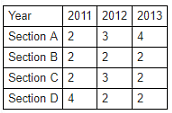
Q. What was the highest marks obtained by the student of section B in the year 2013?
Directions : In a school, for class 10th the sections are allotted on the basis of the scores of the student in class 9th. There are four sections in class 9th namely A, B, C, D. A student obtaining highest marks will be allotted section P in class 10th. On the similar basis sections Q, R, S are allotted. P is the best section, Q, R and S are the 2nd, 3rd and 4th best section respectively.
A record of score of 10 students were kept.
Each year the lowest and highest score increases by 1.
Each student got distinct marks as per record of January, 2011, the minimum marks is 20 and the maximum marks is 29. The sections were to be continued for 1 year in class 10th. Different sets of number of students are there in class 9th for any two year. In class 10th, section P has 4 students and, Q, R, S have 2 students each.
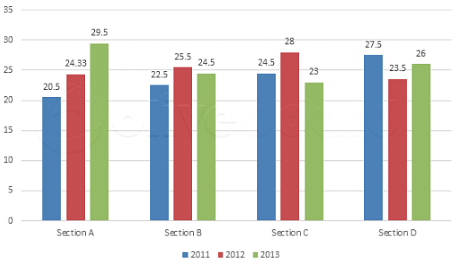
The below table gives the number of students in each section of class 9th over the years:

Q. The top scorer was present in which section in 2013?
Directions: In a school, for class 10th the sections are allotted on the basis of the scores of the student in class 9th. There are four sections in class 9th namely A, B, C, D. A student obtaining highest marks will be allotted section P in class 10th. On the similar basis sections Q, R, S are allotted. P is the best section, Q, R and S are the 2nd, 3rd and 4th best section respectively.
A record of score of 10 students were kept.
Each year the lowest and highest score increases by 1.
Each student got distinct marks as per record of January, 2011, the minimum marks is 20 and the maximum marks is 29. The sections were to be continued for 1 year in class 10th. Different sets of number of students are there in class 9th for any two year. In class 10th, section P has 4 students and, Q, R, S have 2 students each.
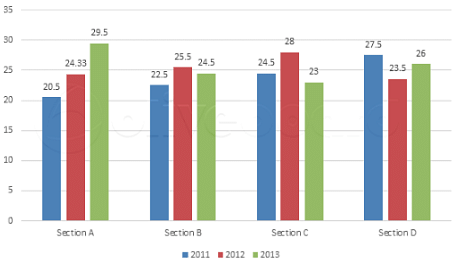
The below table gives the number of students in each section of class 9th over the years:

Q. Total number of students from section C moved in section Q in the year 2011 is what was the highest marks obtained by the student of section B in the year 2013?
Directions: In a school, for class 10th the sections are allotted on the basis of the scores of the student in class 9th. There are four sections in class 9th namely A, B, C, D. A student obtaining highest marks will be allotted section P in class 10th. On the similar basis sections Q, R, S are allotted. P is the best section, Q, R and S are the 2nd, 3rd and 4th best section respectively.
A record of score of 10 students were kept.
Each year the lowest and highest score increases by 1.
Each student got distinct marks as per record of January, 2011, the minimum marks is 20 and the maximum marks is 29. The sections were to be continued for 1 year in class 10th. Different sets of number of students are there in class 9th for any two year. In class 10th, section P has 4 students and, Q, R, S have 2 students each.
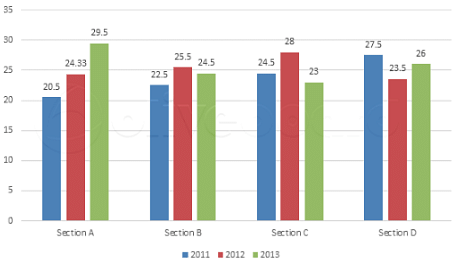
The below table gives the number of students in each section of class 9th over the years:
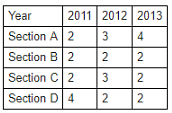
Q. Students of how many sections showed a consistent increase in marks obtained?
Directions: In the 1st Semester at NIM, students have five papers, each of which is graded on a 9 point grading scale. The marks to grade conversion is as follows:-

The below table depicts the marks scored by each students in the 5 papers they had to appear for in Semester - 1. The values of X, Y and Z have been intentionally removed from the Table.

The following additional information is also known:-
(i) Only 2 of the six students have the same CQPI, and they are Shujoy and Pooja
(ii) The average of the CQPI obtained by Abhishek and Namrata is equal to that of Shujoy and Sanjay
(iii) Though Namrata's total marks obtained is not the lowest, she has the lowest CQPI of the six students
(iv) The total marks obtained by the six students in Marketing - I is more than what was obtained by them in exactly 2 of the remaining 4 papers
(v) The CQPI for the students are computed by dividing the total Grade Points obtained by the number of papers they appeared for in each semester
Q. What is the sum of the marks obtained by Shujoy in his five papers in Semester - 1?
Directions: In the 1st Semester at NIM, students have five papers, each of which is graded on a 9 point grading scale. The marks to grade conversion is as follows:-
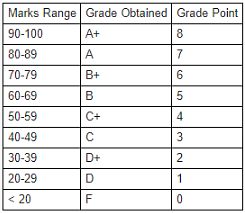
The below table depicts the marks scored by each students in the 5 papers they had to appear for in Semester - 1. The values of X, Y and Z have been intentionally removed from the Table.

The following additional information is also known:-
(i) Only 2 of the six students have the same CQPI, and they are Shujoy and Pooja
(ii) The average of the CQPI obtained by Abhishek and Namrata is equal to that of Shujoy and Sanjay
(iii) Though Namrata's total marks obtained is not the lowest, she has the lowest CQPI of the six students
(iv) The total marks obtained by the six students in Marketing - I is more than what was obtained by them in exactly 2 of the remaining 4 papers
(v) The CQPI for the students are computed by dividing the total Grade Points obtained by the number of papers they appeared for in each semester
Q. What is the minimum possible value of Z?
|
16 videos|27 docs|58 tests
|
|
16 videos|27 docs|58 tests
|


